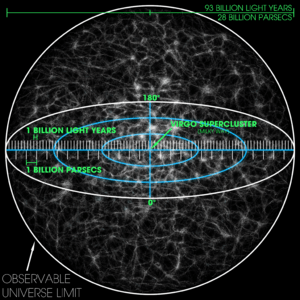Shape of the universe facts for kids
The shape of the Universe is a really big and interesting topic! It's not like talking about the shape of a ball or a box. When scientists talk about the Universe's shape, they use special ideas from Albert Einstein about how space and time work. This means the normal geometry we learn in school, called Euclidean geometry, doesn't quite fit.

It's tricky to talk about "the shape of the universe at one exact moment." This is because of Einstein's special theory of relativity. It tells us that what one person sees as happening at the same time might not be the same for someone else in a different place. So, scientists don't usually try to find the shape of the whole universe at a single moment in time.
Instead, astrophysicists (scientists who study space) create different models of the universe. They then check if these models match what they see and measure in space. We can only observe a part of the whole universe, called the observable universe. This is like a giant bubble around us. Every spot in the universe has its own observable universe, and they might overlap or be completely different!
Understanding the Universe's Shape
When we talk about the shape of the universe, we can think about two main things:
- Local geometry: This is about the curvature of space, especially in the part of the universe we can see. Imagine walking on a giant surface. Is it flat like a table, curved like a ball, or curved like a saddle?
- Global geometry: This is about the overall shape or topology of the entire universe. It's like asking if the universe is infinite or if it loops back on itself, like a video game where you go off one side and appear on the other. This global shape is much harder, or maybe even impossible, to measure.
What We Observe About the Universe
The observable universe is the part we can see and study. It's a sphere (a ball shape) with us right in the middle. Scientists use observations from this area to test their ideas about the universe.
Recent measurements, especially from NASA, suggest something very interesting: the universe appears to be flat. This means it's not curved like a ball or a saddle, at least not within the part we can observe. Scientists say it's flat with only a tiny margin of error, about 0.4%.
One popular model that fits these observations is called the FLRW model. In this model, the universe is thought to be infinite and flat. However, there are other models that also match what we see. Scientists are still working to understand the true shape and size of the entire universe!
See also
 In Spanish: Forma del universo para niños
In Spanish: Forma del universo para niños


